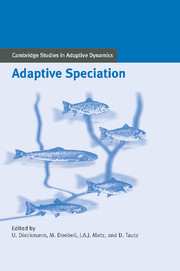Book contents
- Frontmatter
- Contents
- Contributing Authors
- Acknowledgments
- Notational Standards
- 1 Introduction
- 2 Speciation in Historical Perspective
- A Theories of Speciation
- B Ecological Mechanisms of Speciation
- C Patterns of Speciation
- 15 Phylogeography and Patterns of Incipient Speciation
- 16 Evolutionary Diversification of Caribbean Anolis Lizards
- 17 Adaptive Radiation of African Montane Plants
- 18 Diversity and Speciation of Semionotid Fishes in Mesozoic Rift Lakes
- 19 Epilogue
- References
- Index
17 - Adaptive Radiation of African Montane Plants
Published online by Cambridge University Press: 05 July 2014
- Frontmatter
- Contents
- Contributing Authors
- Acknowledgments
- Notational Standards
- 1 Introduction
- 2 Speciation in Historical Perspective
- A Theories of Speciation
- B Ecological Mechanisms of Speciation
- C Patterns of Speciation
- 15 Phylogeography and Patterns of Incipient Speciation
- 16 Evolutionary Diversification of Caribbean Anolis Lizards
- 17 Adaptive Radiation of African Montane Plants
- 18 Diversity and Speciation of Semionotid Fishes in Mesozoic Rift Lakes
- 19 Epilogue
- References
- Index
Summary
Introduction
The mountains of central and eastern Africa constitute a model system for studying the ecological context and consequences of speciation and adaptation in plants. Unlike most mountains elsewhere in the world, these form “islands in the sky” because their isolated, predominantly volcanic peaks rise far above the surrounding plains and plateaus. These mountains are sufficiently tall to support an altitudinally stratified set of vegetation zones (Hedberg 1951; Figure 17.1), they are sufficiently numerous to provide repeats of this “natural experiment” (Hedberg 1957; Mabberley 1973), and their age and arrangement around the Lake Victoria basin permit the effects of time and position to be disentangled (Knox and Palmer 1998). Distances between mountains range from 50 to 1000 km, and the equatorial location minimizes the effect of climatic variation, with the vegetation displaced less than 1000 m downward during glacial maxima (Hamilton 1982). This model system can be conceptualized as an array of insular habitats amenable to biogeographic analysis (Knox 1999). For groups of plants such as the giant senecios (Dendrosenecio) and giant lobelias (Lobelia) that occupy cells of this array, the inherent bifurcating process of lineage separation during adaptive radiation necessitates some repetition of the evolutionary process as repeated altitudinal speciation (into the set of habitats present on each mountain), repeated geographic speciation (after colonization of a mountain), or a combination of both (Knox and Palmer 1998; Figure 17.2).
- Type
- Chapter
- Information
- Adaptive Speciation , pp. 345 - 361Publisher: Cambridge University PressPrint publication year: 2004
- 6
- Cited by

